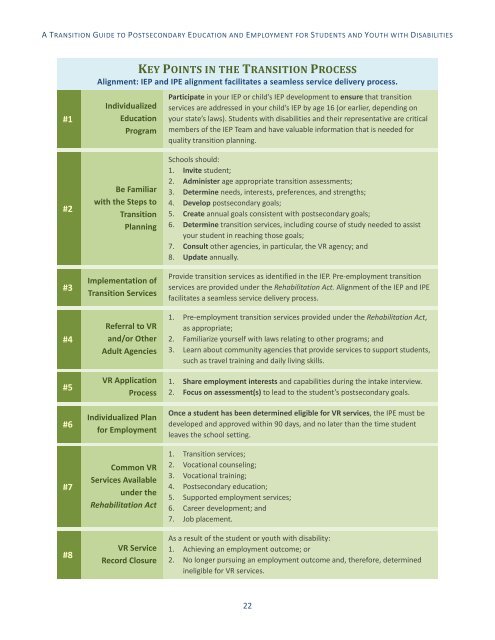TRANSITION GUIDE
2j9tM4H
2j9tM4H
You also want an ePaper? Increase the reach of your titles
YUMPU automatically turns print PDFs into web optimized ePapers that Google loves.
A <strong>TRANSITION</strong> <strong>GUIDE</strong> TO POSTSECONDARY EDUCATION AND EMPLOYMENT FOR STUDENTS AND YOUTH WITH DISABILITIES<br />
#1<br />
KEY POINTS IN THE <strong>TRANSITION</strong> PROCESS<br />
Alignment: IEP and IPE alignment facilitates a seamless service delivery process.<br />
Individualized<br />
Education<br />
Program<br />
Participate in your IEP or child’s IEP development to ensure that transition<br />
services are addressed in your child’s IEP by age 16 (or earlier, depending on<br />
your state’s laws). Students with disabilities and their representative are critical<br />
members of the IEP Team and have valuable information that is needed for<br />
quality transition planning.<br />
#2<br />
#3<br />
#4<br />
#5<br />
#6<br />
#7<br />
#8<br />
Be Familiar<br />
with the Steps to<br />
Transition<br />
Planning<br />
Implementation of<br />
Transition Services<br />
Referral to VR<br />
and/or Other<br />
Adult Agencies<br />
VR Application<br />
Process<br />
Individualized Plan<br />
for Employment<br />
Common VR<br />
Services Available<br />
under the<br />
Rehabilitation Act<br />
VR Service<br />
Record Closure<br />
Schools should:<br />
1. Invite student;<br />
2. Administer age appropriate transition assessments;<br />
3. Determine needs, interests, preferences, and strengths;<br />
4. Develop postsecondary goals;<br />
5. Create annual goals consistent with postsecondary goals;<br />
6. Determine transition services, including course of study needed to assist<br />
your student in reaching those goals;<br />
7. Consult other agencies, in particular, the VR agency; and<br />
8. Update annually.<br />
Provide transition services as identified in the IEP. Pre-employment transition<br />
services are provided under the Rehabilitation Act. Alignment of the IEP and IPE<br />
facilitates a seamless service delivery process.<br />
1. Pre-employment transition services provided under the Rehabilitation Act,<br />
as appropriate;<br />
2. Familiarize yourself with laws relating to other programs; and<br />
3. Learn about community agencies that provide services to support students,<br />
such as travel training and daily living skills.<br />
1. Share employment interests and capabilities during the intake interview.<br />
2. Focus on assessment(s) to lead to the student’s postsecondary goals.<br />
Once a student has been determined eligible for VR services, the IPE must be<br />
developed and approved within 90 days, and no later than the time student<br />
leaves the school setting.<br />
1. Transition services;<br />
2. Vocational counseling;<br />
3. Vocational training;<br />
4. Postsecondary education;<br />
5. Supported employment services;<br />
6. Career development; and<br />
7. Job placement.<br />
As a result of the student or youth with disability:<br />
1. Achieving an employment outcome; or<br />
2. No longer pursuing an employment outcome and, therefore, determined<br />
ineligible for VR services.<br />
22


